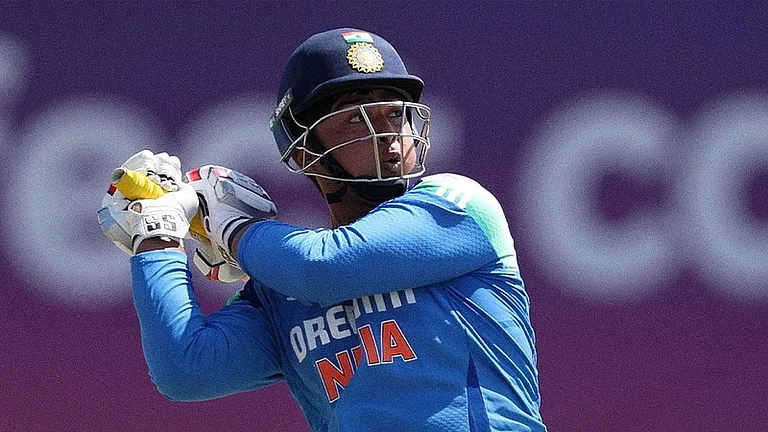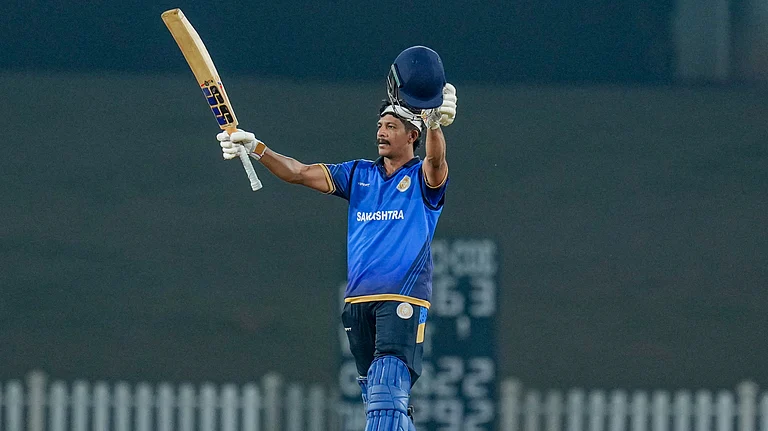What is left unsaid in the story of Krishna and Kamsa in the Kamsavadham Kathakali was brought out in a new Attakatha staged recently in Tripunithura. Kamsa Janardhanam performed by the artists from Gandhi Seva Sadanam Kathakali Academy at Perur in Palakkad, brought in a new visual experience –the backdrop for Kamsavadham – The killing of Kamsa.
Organised by Tripunithura Kathakali Kendra as part of its monthly programme, Kamsa Janardhanam took the audience through the helplessness of Kamsa’s father Ugrasen, who was imprisoned by his own son; the ordeal of Devaki and Vasudeva as they witnessed Kamsa killing their children born in prison; their mental state before the birth of the promised 8th son and so on.
The new attakatha (stage manual) has all the drama to keep the audience on the edges of their seats and enough scope for the artists to perform. While Kamsa takes centre stage in the story, the scene depicting Vasudeva and Devaki’s troubled state of mind strikes a chord with the audience. The visual depiction of Mahavishnu’s apparition in the prison comforting the beleaguered couple was a pleasant sight. The enactment on stage was about various incidents that brought about the violent end of this king by his own nephew, Krishna. The presence of Krishna, the hero of the play, is felt throughout the play, though he makes an appearance only in the last scene to enact the killing of Kamsa.
The stagecraft of Kathakali is not easy. The songs take the story forward as interactions between characters and they also connect a scene to the next. It should have the elements for the Kathakali artists to dwell on stage and the songs should be set to tune such that it not just conveys the mood on the stage but should also appeal to the audience.
Kamsa Janardhanam follows the basic storyline of Kamsavadham. The author of the new attakatha however uses the creative space to bring other characters on stage to life. Sadanam K. Harikumar, the writer, lyricist, composer, singer, and director of the play feels the story was waiting to happen because the trauma experienced by Devaki, Vasudeva, and Ugrasen as told in the Bhagavatham has surprisingly not been told in Kathakali earlier.
Even though all our stories are from the Puranas, this story has a connection with the present because of the 'Sisu hatya’. Everywhere born and unborn children are victims of many crimes in modern-day too, he added. Kamsa is on a killing spree, and he had snuffed so many innocent lives in and around Mathura who were born around the same time as Devaki's eighth son, who was a threat to his own existence.
Kathakali guru FACT Padmanabhan, who watched the performance, said that the story was well depicted, and the audience would have no problem appreciating it. However, keeping in mind the need of modern times, the staging manual needs to be made a bit crisper to keep it within the three-hour time.
There were scenes in prison that were performed only with mudras while sitting on the stage floor. Maybe a couple of lines would help the non-Kathakali followers to understand it better and save time too. The artists too need to brush up on how to best use the stage and the mudras, especially when it is a new story. Padmanabhan Asan said that the experience of the new story was good, and it had various nuances in which artistes could excel on stage.
Writer, musician, and traditional art aficionado Ramesan Thampuran in Tripunithura said that while the basic storyline of Kamsavadham remained, it was interesting to see the visualization of different parts of the story. There was a slight lag in the presentation, but overall, the new Attakatha was well conceived. The prison scene could be better depicted, perhaps, he added.
Balancing Modernity And Traditions
M. R. S. Menon, Patron of Tripunithura Kathakali Kendra, said such new Attakathas are necessary to take Kathakali art form forward in modern times. Overall, the presentation of the story was good and Sadanam Harikumar’s creativity in all spheres of the art form has helped in bringing out a story that is likely to have a good run across various stages in Kerala.
But it was not a cakewalk with this Attakatha for Dr. Harikumar, who had so far written 21 Kathakali attakathas, mostly based on the characters from the Puranas, picking up the threads of the untold stories for Kathakali. This is the fifth stage of the story and the earlier stages were more than two years ago before the Covid 19 pandemic put a full stop to all art shows.
Sapamochanam, his first Attakatha that he wrote when he was still at Shantiniketan, is about the interactions between Urvashi and Arjuna and how the curse she utters becomes a blessing for the Pandava warrior later. He went on to write the attakatha for stories on Abhimanyu, Shikhandi, Ekalavya, Darika Vadham, and many more including one based on Julius Ceasar which was titled Charudattan.
However, he finds it difficult to make these stories popular as the demand for Kathakali is for the age-old stories that have been popularised by stalwarts in Kathakali. The audience is always connecting with these stories to relive the enactments of the stalwarts.
But there are a few Kathakali followers who love to see new stories taken to the stage. And J Gopakumar, president of the Kathakali Aswadaka Sangam, Mavelikkara, is one among them. “I had initiated a few new Kathakali performances, but these stories will have more acceptance only if they are performed at other stages as well. The attakatha writers need to keep the technicalities of Kathakali in mind, he said. Karnasapatham, one of the most popular among ‘new’ attakathas, is more of a one-act play and keeps the audience’s attention for the whole performance.
Perhaps, therein lies the indication of the necessity of modern times. Kathakali performances, which were written and held in an all-night show in the past, have now come to be staged in a three-hour show. These changes have come up in the last two decades. In recent times, one-hour shows have come to be accepted in which just one or two scenes of a story are enacted.
An experiment by the late lyricist and Kathakali enthusiast B. R. Prasad to bring on stage Lalithasahasranamam in the Kathakali art form was received well, says Mr. Gopakumar, who was part of organising the show. The temple precincts that staged the show in the daytime had many women lipping the slokas along with the Kathakali performance. There are quite a few writers who have provided new stories to be enacted, like Krishnaleela, Bhima Darshanam (based on M T Vasudevan’s Randamoozham), Urmila, Kapidwajayam, Arjuna Vishada Vrittam, Ramanan, Poonthanam and Kumarasambhavam. Unfortunately, it is only the writer of these stories who seeks the performance of these new stories to be added to Kathakali’s repertoire. The general tendency of the aswadakas is to revisit old stories.
Kathakali artiste Renjini Suresh also feels that new stories have not been able to create space in Kathakali mainly because of the audience demand for age-old stories. New stories are a challenge and organisers are seldom ready to take these risks, she added.
While on one hand, the challenge of the Attakatha writers is to adjust to the demands of the modern times in keeping the play time-bound to a maximum of three hours, on the other hand, there is also the lack of panache of the modern-day artists to learn new plays. The stalwarts in Kathakali also have a role, perhaps, in taking initiative in picking up new stories for their show.
There are few takers for new stories among organisers and followers, mostly because they are not familiar with the songs, and they are unsure about how it would play out on stage.
What is it about the Kathakali aficionados making it to every performance in their area or even traveling to other places just to see a particular performance? Mostly, It is to watch how various artistes present a particular character in his own style. It is also the performances of stalwarts in the field that had associated them with certain characters. Such a following led to the formation of many Kathakali clubs at various places across Kerala bringing Kathakali to every town. Many temples had added Kathakali as one of their major shows during festivals, thus further adding many more stages for the art.
In the times when there are quite a few artistes and many stages too to promote Kathakali, experimentation with new stories is perhaps the way forward. The creativity of the artists only enhances when they take on new challenges.



























